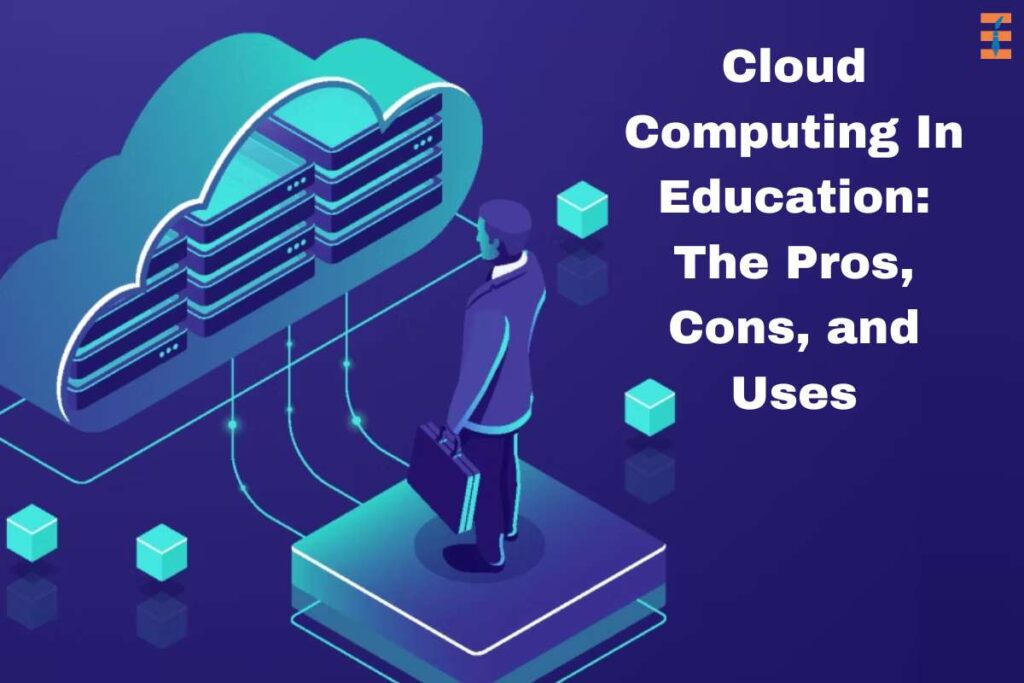Cloud Computing has transformed the way we work and live. Whether it is through emails, watching movies, or streaming music, cloud computing plays a role in all of these things. Cloud Computing in Education has transformed the way of education.
Education is one of the fields where cloud computing has made a significant impact. The tasks of teaching and learning are no longer limited to textbooks and have now shifted toward digital devices such as mobile phones and computers, with technology at the forefront.
The technology of cloud computing has helped connect the non-virtual world to a virtual one. Using this technology, computing resources can be shared anytime and anywhere. Cloud computing is a platform that has made teaching and learning more efficient than it was about a decade ago.
Whether it’s a college, school, or university, the data can be stored and maintained on cloud servers and data centers without buying or owning them. For their specific use, they can benefit from cloud computing in education for their databases, storage, and other service requirements without worrying about data security. Let’s learn more about what is Cloud Computing in Education and its negative and positive aspects.
What is Cloud Computing?
A cutting-edge Internet-based technology called cloud computing enables on-demand access to services, storage space, and resources without the worry of downloading or installing anything on your computer.

In essence, a large number of people from all over the world would be able to access knowledge and services, as well as their knowledge and documents, from any device that is connected to the internet, eliminating the need for large native knowledge centers.
What would be the academic benefits of many people worldwide having access (if authorized) to at least one another through distributed services? There are undoubtedly economic benefits to the existing situation.
Uses of Cloud Computing:
- Cloud Computing facilitates the development, deployment, and scaling of applications, utilizing approaches like API communication, DevOps, and Kubernetes for creating cloud-based native applications.
- It reduces development costs and time by leveraging scalable cloud infrastructures.
- Cloud computing ensures data protection and preservation by transferring and managing data over the internet, making it easily accessible from any location and device.
- It unifies data from various platforms and employs cloud services such as AI and Machine Learning to gain deep insights into the data.
- Cloud Computing enables seamless audio/video streaming anytime and anywhere.
- Intelligent models are used in Cloud Computing to engage consumers and extract valuable information from acquired data.
- Cloud Computing offers consumers access to the latest software versions and updates, simplifying their daily tasks.
- For those interested in pursuing a career in Cloud Computing, Cloud Architect Certifications provide both theoretical and practical knowledge, opening doors to high-paid jobs in top companies.
Pros of Cloud Computing in Education:
1. Online Education Guidance
The e-learning platform introduces a convenient and effective mode of education known as online learning. It utilizes cloud computing, eliminating the need to store and transfer data on physical devices. Students can create a growing repository of knowledge accessible anytime they need it.
2. Customized Learning

Cloud computing in education enables personalized learning experiences. Students can access a wide range of resources and software tools that align with their learning styles and interests using an Internet-connected device.
3. Cost Reduction
Cloud-based services help educational institutions lower expenses and adopt new technologies quickly to meet evolving academic requirements. It offers affordable solutions to researchers, faculty, and students, allowing them to use applications like office tools without the need for individual purchases.
4. Accessibility
The most valuable aspect of education cloud services is their continuous availability, 24/7, without any downtime. Students can log in from anywhere and access their data, work on files, and use browser-based applications across various devices, including mobile, laptop, and desktop computers.
5. Infrastructure Enhancement
Cloud computing allows schools and governments to focus on their primary goals of providing more research facilities and creating a global learning environment, while the infrastructure concerns, such as buildings and labs, are taken care of by the cloud provider.
6. Environmental Impact
The education cloud contributes to environmental sustainability by reducing the carbon footprint associated with traditional computing and data storage methods.
7. User-Friendly
The education cloud is designed to be user-friendly, making it easy for students to create content through the browser interface without unnecessary complexity.
8. Data Monitoring
Cloud computing simplifies data monitoring since all access points are consolidated in one place. This eliminates the need to supervise numerous individual computers across a large geographical area and allows for easier implementation of security measures.
Limitations of Cloud Computing in Education:

Dependency on Internet Connectivity
Cloud Computing is reliant on a fast and stable internet connection; its effectiveness is heavily influenced by the quality of service provided by cloud service providers and the connectivity itself. If there are issues with the server, it can lead to poor overall server quality. Therefore, a strong server connection is essential to fully utilize the potential of cloud computing.
While there are indeed some disadvantages to using Cloud Computing in education, such as server performance, data management, and user experience, it doesn’t mean that the technology should be avoided altogether. Cloud Computing has helped us simplify our lives, allowing us to perform various tasks efficiently, such as streaming music and working with documents. It is widely adopted across various fields and remains an invaluable tool despite its drawbacks.
To fully utilize the advantages of cloud computing, your business must have a reliable internet connection. Unfortunately, there is no way to avoid this requirement.
1. Feature Limitations
Cloud providers vary in their offerings. When utilizing cloud computing for storage and backup, it is preferable to work with a provider that offers the benefit of unlimited bandwidth.
2. Cloud Misuse
While cloud computing provides a level of security making it nearly impossible for criminals to locate and steal specific data stored on machines, such as tests, exam questions, or results, there are still hackers and thieves who will exploit vulnerabilities in cloud-based services.
3. Bandwidth Constraints
Many cloud storage services impose specific bandwidth limitations. If a company exceeds the allocated bandwidth, additional charges could be substantial.
Also Read: The 10 Best Trending IT Certifications










